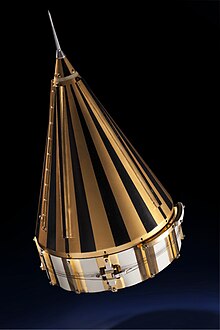Pioneer 3
Pioneer 3 was a spin-stabilized spacecraft launched at 05:45:12 GMT[1] on 6 December 1958 by the U.S. Army Ballistic Missile Agency in conjunction with NASA, using a Juno II rocket.
This spacecraft was intended as a lunar probe, but failed to go past the Moon and into a heliocentric orbit as planned.
The cone was composed of a thin fiberglass shell coated with a gold wash to make it electrically conducting and painted with black and white stripes to maintain the temperature between 10 and 50 °C.
The flight plan called for the Pioneer 3 probe to pass close to the Moon after 33.75 hours and then go into solar orbit.
It re-entered Earth's atmosphere and burned up over Africa on 7 December at approximately 19:51 GMT (2:51 p.m. EST) at an estimated location of 16.4° N, 18.6° E. The probe returned telemetry for about 25 hours of its 38-hour-6-minute journey.
[2] While Pioneer 3 did not meet its primary mission objective of a lunar flyby, the data obtained was of particular value to James Van Allen.

